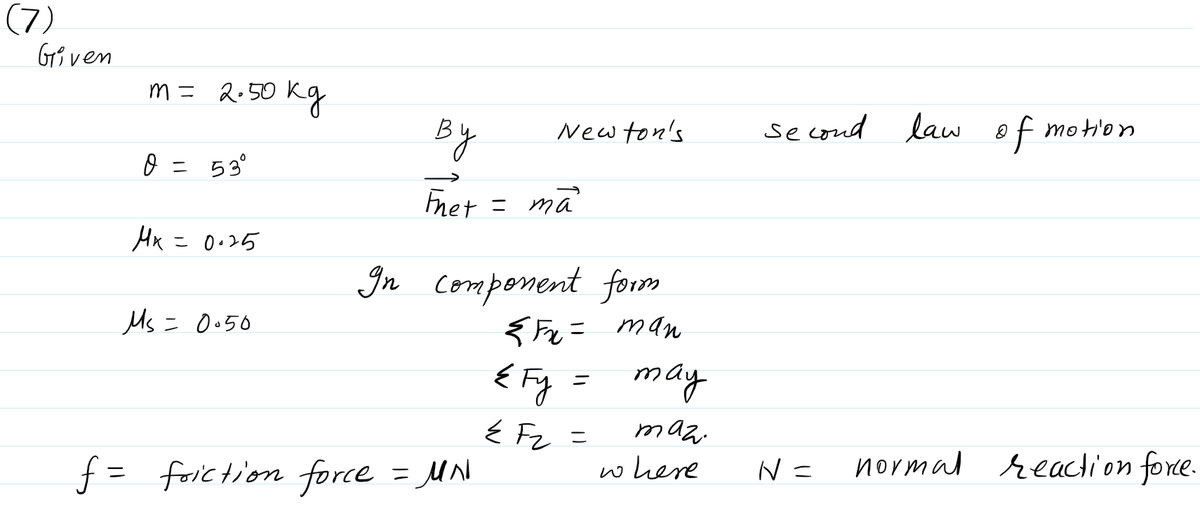For number 7 7) A 2.50-kg block is on a 53.0° incline for which Mk = 0.25 and Us = 0.50. Find its acceleration given that: (a) it is initially at rest; (b) it is moving up the slope; (c) it is moving down the slope. Part a b and c I need to draw picture and show all work formula please
For number 7 7) A 2.50-kg block is on a 53.0° incline for which Mk = 0.25 and Us = 0.50. Find its acceleration given that: (a) it is initially at rest; (b) it is moving up the slope; (c) it is moving down the slope. Part a b and c I need to draw picture and show all work formula please
College Physics
11th Edition
ISBN:9781305952300
Author:Raymond A. Serway, Chris Vuille
Publisher:Raymond A. Serway, Chris Vuille
Chapter1: Units, Trigonometry. And Vectors
Section: Chapter Questions
Problem 1CQ: Estimate the order of magnitude of the length, in meters, of each of the following; (a) a mouse, (b)...
Related questions
Question
For number 7
7) A 2.50-kg block is on a 53.0° incline for which Mk = 0.25 and Us = 0.50. Find its acceleration given that: (a) it is initially at rest; (b) it is moving up the slope; (c) it is moving down the slope.
Part a b and c I need to draw picture and show all work formula please

Transcribed Image Text:**Problem 7**: A 2.50-kg block is on a 53.0° incline for which the coefficient of kinetic friction \(\mu_k = 0.25\) and the coefficient of static friction \(\mu_s = 0.50\). Find its acceleration given that:
(a) it is initially at rest;
(b) it is moving up the slope;
(c) it is moving down the slope.

Transcribed Image Text:**Physics Problem Flow Chart**
1. **Draw a picture**
- Label which directions are positive (x- and y-), and label relevant quantities on the diagram.
2. **Draw a second picture...**
- If you have before/after situations, force additions, vector component diagrams.
3. **Identify explicitly given values**
- Write all given actual numbers in terms of variables. For previously calculated values, use values before rounding for sig figs.
4. **Identify implicitly given values**
- Wording that implies specific values: e.g., "at rest," "comes to a stop," "dropped," "smooth surface," "constant velocity."
5. **Identify required quantity and type of problem**
- Look for keywords like "when," "how far," "how fast," etc. Get type of problem from quantities given/sought.
6. **Calculate/convert easily derived quantities**
- For example, the x- and y-components of velocity/force vectors, or the force of gravity given the mass.
7. **Find relevant equation(s)**
- One that links the given quantities to the quantity you need to find.
8. **Find a second equation...**
- If you're missing a quantity needed to use an equation. Draw up a plan on how to link the equations & quantities.
9. **Solve for the quantity without using numbers**
- First, cancel any quantities that are zero. Use algebra to isolate the quantity you need on one side of the equals sign. Check with dimensional analysis.
10. **Sub in numbers on paper**
- Make sure units of each number are correct before you substitute in values into the equations.
11. **Use calculator to find value**
- Use as few presses of the "=" or "ENTER" button as possible. Keep extra sig figs until next step.
12. **Write conclusion statement with correct sig figs**
- In plain English with correct units.
Expert Solution
Step 1: Determine the given variables.
Step by step
Solved in 5 steps with 5 images

Knowledge Booster
Learn more about
Need a deep-dive on the concept behind this application? Look no further. Learn more about this topic, physics and related others by exploring similar questions and additional content below.Recommended textbooks for you

College Physics
Physics
ISBN:
9781305952300
Author:
Raymond A. Serway, Chris Vuille
Publisher:
Cengage Learning

University Physics (14th Edition)
Physics
ISBN:
9780133969290
Author:
Hugh D. Young, Roger A. Freedman
Publisher:
PEARSON

Introduction To Quantum Mechanics
Physics
ISBN:
9781107189638
Author:
Griffiths, David J., Schroeter, Darrell F.
Publisher:
Cambridge University Press

College Physics
Physics
ISBN:
9781305952300
Author:
Raymond A. Serway, Chris Vuille
Publisher:
Cengage Learning

University Physics (14th Edition)
Physics
ISBN:
9780133969290
Author:
Hugh D. Young, Roger A. Freedman
Publisher:
PEARSON

Introduction To Quantum Mechanics
Physics
ISBN:
9781107189638
Author:
Griffiths, David J., Schroeter, Darrell F.
Publisher:
Cambridge University Press

Physics for Scientists and Engineers
Physics
ISBN:
9781337553278
Author:
Raymond A. Serway, John W. Jewett
Publisher:
Cengage Learning

Lecture- Tutorials for Introductory Astronomy
Physics
ISBN:
9780321820464
Author:
Edward E. Prather, Tim P. Slater, Jeff P. Adams, Gina Brissenden
Publisher:
Addison-Wesley

College Physics: A Strategic Approach (4th Editio…
Physics
ISBN:
9780134609034
Author:
Randall D. Knight (Professor Emeritus), Brian Jones, Stuart Field
Publisher:
PEARSON
